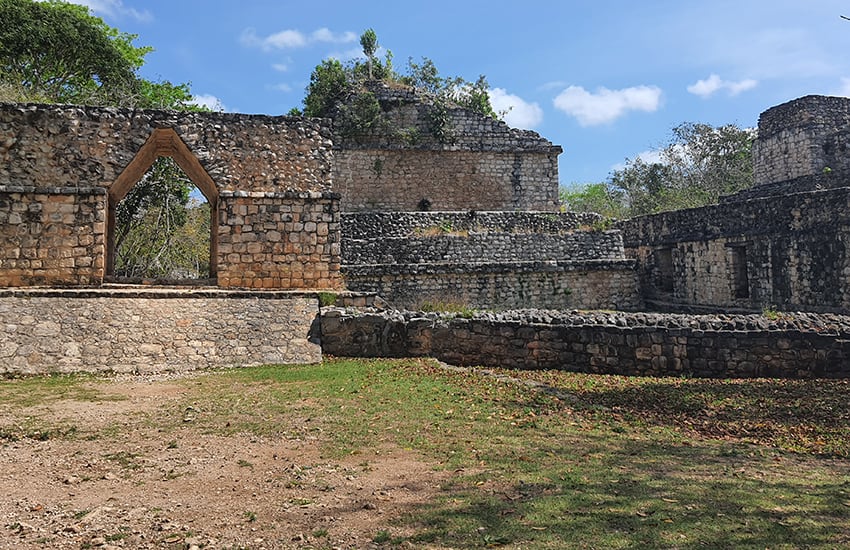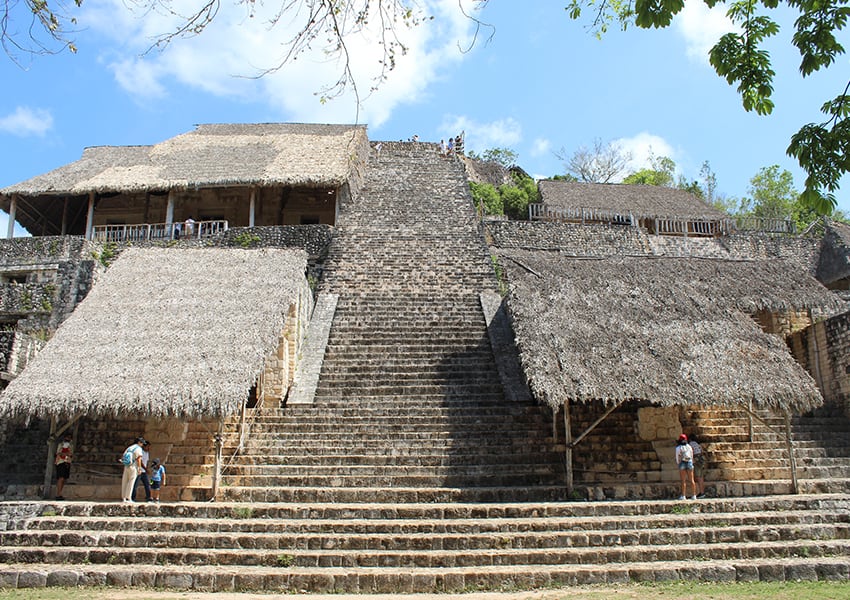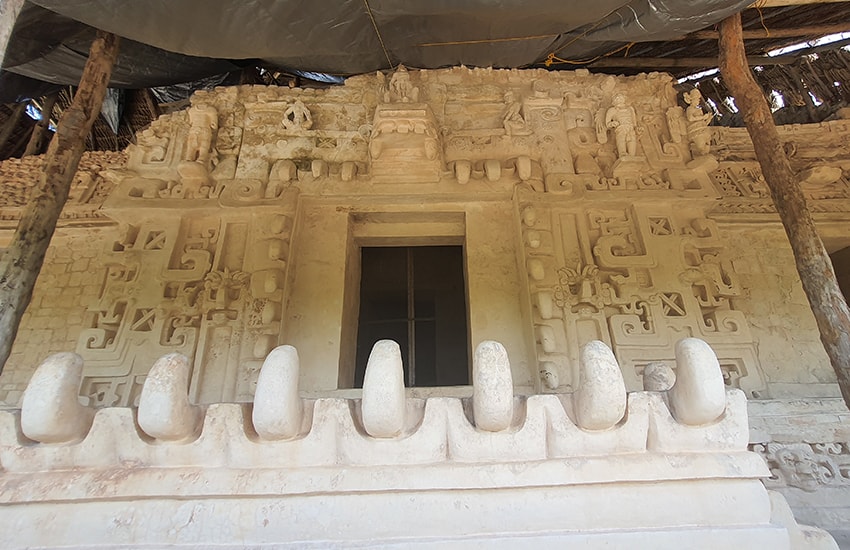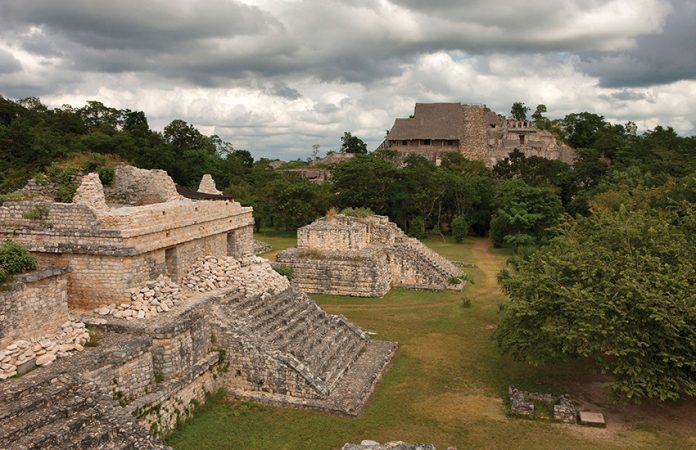Situated 27 kilometers from Valladolid, Yucatán, off Highway 295, the archaeological zone of Ek’ Balam has one of the largest ancient Maya structures in Mesoamerica, the area from central Mexico to northern Costa Rica. Hidden in the jungles, the site is near several cenotes and close to the famous Maya city of Chichén Itzá.
The site was mentioned in the Spanish document “Relación de Ek’ Balam” in 1579 by Juan Gutiérrez Picón, although archaeological explorations only commenced in the late 20th century. The name is Yucatec Mayan for dark jaguar or black jaguar as well as bright star jaguar.
The site is widely thought to be named after the founding ruler, Ek’ Balam, or Coch Cal Balam, who supposedly ruled for 40 years, but the National Institute of Anthropology and History (INAH) says evidence of such a king has not been discovered. Archaeologists have identified five rulers so far from the glyphs found onsite.
Ek’ Balam, identified as the capital of the Talol kingdom, was occupied from around 300 B.C. and then peaked in development during A.D. 600–900. It was abandoned in the 16th century. During its peak, the settlement reached around 12 square kilometers, although the walled area is only about one square kilometer. Hence it is a relatively small archaeological zone.
The site has 45 structures, three walls, and five “white roads” — ancient gravel roads with a white surface — as well as tall, sculpted stone stelae and other monuments. Archaeologists have noted overlapping construction stages and different architectural styles here.

Two walls surround the main area, and the third connects the key buildings. The walls are thought to have symbolically barred access to certain sections of the site, since at an estimated height of around 1 1/2 meters, they are too low to serve as defense. Still, a defensive purpose is also considered a possibility.
We entered the site from one of the white roads on the south. At the entrance is a beautiful arch-like structure with a ramp, considered the main entrance to the walled section of the site.
East of the entrance is the South Plaza. An interesting structure here is a round building on a rectangular base called the Oval Palace, considered an elite residence as well as a ceremonial building. There are several rooms on two floors and a temple on top.
Archaeologists discovered burials and offerings here. The views of the main pyramid and the site from the top of the palace are stunning.
West of the plaza is a structure called the Twins — two identical buildings with separate stairways on a rectangular platform — measuring 40 meters in length, 17 meters in width, and around six meters in height. Two stucco masks were discovered here. No exact purpose for these buildings has been identified, although there has been some speculation they were temples.
East of the plaza is a large structure on a rectangular base with multiple buildings and a temple, also worth seeing. A must-see in this section, however, is the stela from A.D. 840 depicting Ek’ Balam’s rulers.

The South Plaza has the third wall connecting the main buildings, considered possibly ceremonial in purpose. It also restricts access to the central area. The North Plaza has the largest and the oldest buildings of the site.
Perhaps the most significant building of Ek’ Balam is the Acrópolis or the royal palace — a six-level pyramid building measuring 160 meters in length, around 68 meters in width and 32 meters in height. This pyramid has two wings, to the east and west, separated by a large stairway, and there are several structures and passages within the compound.
You can climb to the top of this building, where the panoramic views from the summit are breathtaking. On either side of the main stairways are beautiful serpent-head sculptures with extended tongues and Maya hieroglyphs referred to as the Hieroglyphic Serpents.
An absolute must-see, however, is the fourth-level room whose name Sak Xok Naah means the white house of reading. It houses the tomb of the first known king, Ukit Kan Le’t Tok, or the father of the four flint fronts. He has also been identified as the builder of the Acrópolis pyramid.
Archaeologists found several thousand pieces of funeral offerings here. Although the room is cordoned off to visitors, you will not tire of observing from the outside the extremely well-preserved sculptures and designs of different characters, including angels.
The most notable sculpture, perhaps, is the magnificent stucco piece representing the Earth Monster with its open jaws, which sits by the room’s entrance.

There are additional structures to see on the Acrópolis pyramid, which is also the site where the ancient text Mural of the 96 Glyphs was discovered.
East and west of the North Plaza are two large still-to-be excavated buildings. The Maya ball court southwest of the North Plaza is also worth seeing.
For a refreshing swim after exploring the entire site, the cenote X’Canché, in the jungle around 1 1/2 kilometers from the ruins, is ideal. X’Canché is around 15 meters below ground level, with a diameter of around 50 meters.
You can also engage in adventure sports here, such as zip-lining and rappelling. The tranquil surroundings and the rest area with palapas — umbrella-like manmade structures with palm-leaf thatch roofs and open sides — is a relaxing experience, especially in the hot climate of Yucatán.
Thilini Wijesinhe, a financial professional turned writer and entrepreneur, moved to Mexico in 2019 from Australia. She writes from Mérida, Yucatán. Her website can be found at https://momentsing.com/
